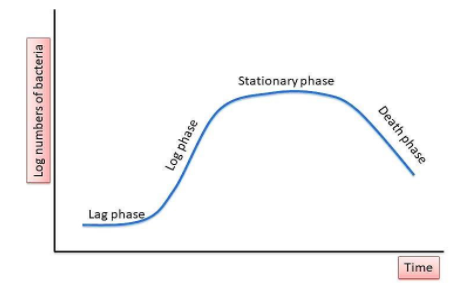
In the log phase, growth is
A. Slowest
B. Fastest
C. Intermediate
D. No growth at all
Answer
463.2k+ views
Hint:
The growth curve of bacterial cells is sigmoid in shape (S-shaped) and is divided into four different
phases i.e., lag phase, log phase, stationary phase, and death phase. The other name for log phase is the exponential phase.
Complete answer:
Option (A) is incorrect. The lag phase of the growth curve is that phase in which the growth is slowest
because, at this phase, bacterial cells are adapting themselves to the new environment. Thus, the
growth is slowest in the lag phase of the growth curve.
Option (B) is correct. The log phase of the growth curve is the phase of cell doubling and hence, the
number of bacterial cells will increase and continue to increase until it meets the stationary phase
(having conditions that limit the growth of bacteria). Thus, there will be an increase in bacterial
population during this phase which implies that the growth will be fastest during this phase. This
increase is due to the proper availability of nutrients and tolerable environmental conditions.
Growth Curve:

Option (C) is incorrect. Intermediate growth does not take place in the log phase because it is the phase of maximum growth as the bacterial population doubles at an exponential rate.
Option (D) is incorrect. In the lag phase of the growth curve, there is little or no growth of bacterial cells because the cells are adapting to new environmental conditions and synthesizing biochemicals.
Hence, the correct option is (B).
Note:
The log phase in the growth curve can be seen as a straight line that is moving upwards. This implies that the growth is increasing at an exponential rate in this phase of the growth curve. Thus, the maximum bacterial population exists during this phase of growth indicating that the growth is fastest during the log phase.
The growth curve of bacterial cells is sigmoid in shape (S-shaped) and is divided into four different
phases i.e., lag phase, log phase, stationary phase, and death phase. The other name for log phase is the exponential phase.
Complete answer:
Option (A) is incorrect. The lag phase of the growth curve is that phase in which the growth is slowest
because, at this phase, bacterial cells are adapting themselves to the new environment. Thus, the
growth is slowest in the lag phase of the growth curve.
Option (B) is correct. The log phase of the growth curve is the phase of cell doubling and hence, the
number of bacterial cells will increase and continue to increase until it meets the stationary phase
(having conditions that limit the growth of bacteria). Thus, there will be an increase in bacterial
population during this phase which implies that the growth will be fastest during this phase. This
increase is due to the proper availability of nutrients and tolerable environmental conditions.
Growth Curve:

Option (C) is incorrect. Intermediate growth does not take place in the log phase because it is the phase of maximum growth as the bacterial population doubles at an exponential rate.
Option (D) is incorrect. In the lag phase of the growth curve, there is little or no growth of bacterial cells because the cells are adapting to new environmental conditions and synthesizing biochemicals.
Hence, the correct option is (B).
Note:
The log phase in the growth curve can be seen as a straight line that is moving upwards. This implies that the growth is increasing at an exponential rate in this phase of the growth curve. Thus, the maximum bacterial population exists during this phase of growth indicating that the growth is fastest during the log phase.
Recently Updated Pages
Class 11 Question and Answer - Your Ultimate Solutions Guide

Master Class 11 English: Engaging Questions & Answers for Success

Master Class 11 Computer Science: Engaging Questions & Answers for Success

Master Class 11 Maths: Engaging Questions & Answers for Success

Master Class 11 Social Science: Engaging Questions & Answers for Success

Master Class 11 Economics: Engaging Questions & Answers for Success

Trending doubts
10 examples of friction in our daily life

What problem did Carter face when he reached the mummy class 11 english CBSE

Difference Between Prokaryotic Cells and Eukaryotic Cells

State and prove Bernoullis theorem class 11 physics CBSE

Proton was discovered by A Thomson B Rutherford C Chadwick class 11 chemistry CBSE

Petromyzon belongs to class A Osteichthyes B Chondrichthyes class 11 biology CBSE




